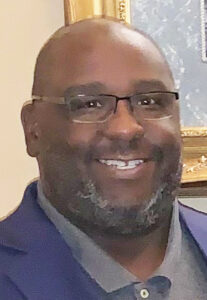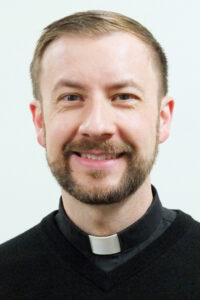 By Barb Arland-Fye
By Barb Arland-Fye
The Catholic Messenger
DAVENPORT — Sometimes, Servant of God Thea Bowman felt like a motherless child in the Catholic Church in the United States. However, she loved her Church, which she entered with passion at age 9, served tirelessly until her death from cancer at age 52 and now is one of six African American Catholics on the path to sainthood.
“A Place At the Table: African Americans On the Path to Sainthood,” tells their stories in an inspiring, yet sobering documentary by Stella Maris Films released earlier this year. Each of the six — Venerable Pierre Toussaint, Servant of God Mary Lange, Venerable Henriette DeLille, Venerable Augustus Tolton, Servant of God Julia Greeley and Servant of God Thea Bowman — faced deep rejection by the Catholic Church. However, they never lost sight of their source of hope, Jesus Christ.
St. Martin de Porres Society of Sacred Heart Cathedral in Davenport showed the documentary Oct. 27 in the cathedral’s Sears Diocesan Hall. The Catholic Church has not yet formally recognized any African American saints “but that could soon change,” the society said in a promotional brochure. “The Catholic Church is starting to recognize (the six Black Catholics’) impact and may soon name any or all of them saints. It’s time to hear their stories.”
St. Martin de Porres Society, Notre Dame Club of the Quad Cities and St. Ambrose University sponsored the documentary showing. “We’re all about supporting a force for good,” said Joe Kehoe of the Notre Dame Club.
Fathers Josh Johnson, Ajani Gibson, Maurice Nutt, Bishop Joseph Perry and Brother Tyrone Davis were among the cast members who wove the threads of the six potential saints into the fabric of the documentary. Each spoke about how the candidate for canonization whose story they told would provide inspiration and hope for other Black Catholics in the U.S.
• Toussaint, an enslaved Haitian man brought to New York, became a popular hair stylist. After gaining his freedom and becoming wealthy, he used his resources to serve the Church and the poor. He and his wife sheltered orphans and he helped establish New York’s first cathedral.
• Mother Lange, founder of the Oblate Sisters of Providence, the first congregation of African American religious in Catholic Church history, was also the first African-American superior of any religious order.
• DeLille, a free woman of color lived in antebellum New Orleans. Religious orders disallowed her from becoming a nun because of her African heritage. She persisted in her calling to religious life, taking on a makeshift habit, assuming abject poverty and risking starvation and danger to nurse, feed and educate slaves and the forgotten of society.
• Father Tolton, born into slavery in Missouri and raised Catholic, became the first African American priest. He either joined the Union Army or escaped slavery to gain his freedom. Rejected from seminaries in the U.S. because of his race, he studied in Rome and was ordained a priest. He returned to the U.S. to serve in ministry in Illinois, where he led construction of St. Monica’s Catholic Church, which was considered a national parish for African-Americans.
• Greeley, a former enslaved woman whose enthusiasm for and devotion to the Eucharist impressed even the Jesuits who ministered to her. She received Communion daily and had a devotion to evangelizing and delivering literature about the Blessed Sacrament to firefighters in their fire stations in Denver. She joined the Franciscan Order and worked within the community for the last 18 years of her life.
• Sister Bowman converted to Catholicism as a 9-year-old living in Mississippi with her parents. The ministry of the Franciscan Sisters of Perpetual Adoration and the Missionary Servants of the Most Holy Trinity inspired her. Described as a powerful teacher with a profound love for liturgy and music, she spent her life lovingly encouraging others to encounter God. She was instrumental in the founding of the Institute for Black Catholic Studies (IBCS).
Documentary reaction
“I found ‘A Place At the Table: African Americans On the Path to Sainthood’ very inspirational,” said Thomas Mason IV, chairman and president of St. Martin de Porres Society. “These six

remarkable men and women led extraordinary lives dedicated to serving the Lord, our God. What I found most incredible is that through all the obstacles they encountered such as racism, hatred and rejection by the Church, their deep belief in their faith and in God allowed them to overcome and persevere.”
“I would highly recommend this film to all Catholics who want to know more about the lives of these men and women who led lives of holiness and virtue and their impact on the Catholic Church. As Venerable Henriette DeLille wrote on the inside cover of a book about the Eucharist, ‘I believe in God. I hope in God. I love. I want to live and die for God.’ How can one not find inspiration in these words?”
The documentary “makes me want to know more about these individuals,” said Ryan Saddler, associate vice president for diversity, equity and inclusion at St. Ambrose

University. The documentary addressed the adversity that each of the six Black Catholics faced in the Church and society. Despite that adversity, “their faith was fully intact,” Saddler said.
Father Thom Hennen, the cathedral’s pastor, described the documentary as a powerful mix of narrative, images and video, especially the excerpt from the passionate, insightful talk Sister Bowman

presented to the U.S. bishops in 1989, months before her death.
Father Hennen believes his parishioners would benefit from viewing the documentary, which has inspired him to explore social outreach in the cathedral’s diverse neighborhoods. The Black Catholics in the documentary didn’t go out and tell people, “‘Why don’t you become Catholic?’ They went out and served,” he said.
Saints in the making
Officially canonized or not, saints are persons in heaven who lived heroically virtuous lives, offered their life for others or were martyred for the faith and who are worthy of imitation. A Servant of God is the title given to a person whose sainthood cause is still under investigation.
The three steps to sainthood follow these Church procedures:
• Venerable — The pope formally recognizes a deceased person for having lived a heroically virtuous life or offered their life.
• Blessed — The candidate meets the requirements for Venerable and has had one miracle attributed to his/her intercession. The beatified candidate is accorded limited liturgical veneration.
• Canonization — A second miracle is required after beatification. The Church declares this person to be a saint and worthy of universal veneration.
The pope may waive these requirements. A miracle is not required prior to a martyr’s beatification, but one is required before canonization.
Source: U.S. Conference of Catholic Bishops (www.usccb.org).











